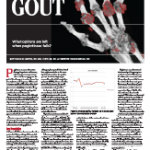Current guidelines for the long-term management of gout recommend a combination of lifestyle management and/or pharmacotherapy to lower serum UA levels to <6.0 mg/dL in most patients or <5.0 mg/dL in patients with more severe disease. Allopurinol is the most widely used xanthine oxidase inhibitor and is recommended in treatment guidelines as a first-line urate-lowering…

FDA Update on Rituximab & Etanercept; Plus New ACP Gout Guideline
The FDA is considering an application for subcutaneous rituximab and has approved an application for etanercept to treat pediatric patients with plaque psoriasis…
Effect of Diet & Sodium Intake on Serum Uric Acid
Serum uric acid (UA) is an important factor in the causal pathway for gout. It has also been implicated as a potential risk factor and/or mediator of cardiovascular disease outcomes and mortality in a large number of observational studies. Although many of the clinical trials targeting serum UA reduction have focused on pharmacologic interventions, diet…
Weight Loss Surgery May Reduce Risk of Developing Gout
(Reuters Health)—Obese people who have weight loss surgeries, such as gastric bypass, are much less likely than those who don’t have surgery to develop gout, a painful type of arthritis, according to a Swedish study. People who chose to get weight loss surgery are also less than half as likely to develop hyperuricemia, too much…

Tocilizumab Designated as Breakthrough Therapy for GCA
To speed the development of tocilizumab to treat giant cell arteritis (GCA), the FDA designated it as a breakthrough therapy earlier this month…

Pharmacokinetics May Be Factor in Success of Pegloticase Therapy for Gout
We read the case report by Dr. Diana Girnita and colleagues (“Severe Refractory Gout: What options are left when pegloticase fails?” The Rheumatologist, August 2016) with interest. A case is reported of a subject with 20 years of chronic refractory gout who failed to respond to pegloticase therapy, and the potential roles of anti-drug antibodies or…
Rheumatology Coding Corner Answer: Gout Visit for Established Patient
CPT: 99213, 89060 ICD-10: M10.072 Coding Rationale This is an established outpatient visit. The encounter is coded as 99213 because it included: History—Expanded problem-focused history. The history of present illness was brief, the review of systems was extended and the past medical and social history was documented. Examination—Detailed. There were seven organ systems examined. This…
Rheumatology Coding Corner Question: Gout Visit for Established Patient
A 55-year-old female patient returns to the office with complaints of gout pain. She is complaining of swelling and a burning pain in her left toe. She has been taking an over-the-counter NSAID to treat the pain, but this has done little to alleviate it. This is her second flare this year. The patient denies…

Gout Treatment & Care Remain Suboptimal
A recent analysis compared the care of patients with RA with that received by patients with gout, finding that hospitalization and costs for patients with gout have increased, but both are decreasing for patients with RA. Unlike RA, significant advances in treatment have not been made for gout, despite its increasing prevalence, and patients may land in the hospital unnecessarily…

New Research into Rheumatoid Arthritis, Gout Includes Updates on Methotrexate, Biologics, Ultrasound
LONDON—From optimizing responses to methotrexate, to the efficacy of biologics, to the need for imaging in assessing remission, the literature, as ever, has been lively with explorations of pressing topics in the treatment and management of rheumatoid arthritis. Josef Smolen, MD, chair of rheumatology at the Medical University of Vienna, reviewed many of the highlights…
- « Previous Page
- 1
- …
- 11
- 12
- 13
- 14
- 15
- …
- 22
- Next Page »